Why do my computer speakers not work?

On this page, we provide information about the most common causes for speakers not working and how to fix those issues. The troubleshooting sections below should be followed in order as they aim to help you identify your problem through the process of elimination.
Volume issues
If you are experiencing problems with the volume of your computer's audio, following these steps may help you fix the problem.

Desktop speakers turned down
This step may seem trivial, but problem-solving works best when you start with the basics. Verify the volume knob on the speakers is turned up enough to produce a sound. Every pair of speakers with knobs increases the volume by turning the volume knob left to right, or clockwise.
Laptop speakers turned down
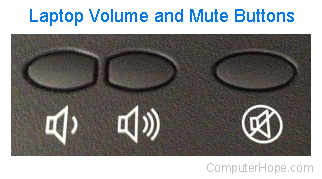
If you are using a laptop computer with no external speakers connected, make sure the volume is turned up with the controls on the keyboard. The volume controls may be buttons (shown in picture) or a secondary function of another key indicated with blue text. To activate these keys, press the Fn key and the secondary function key at the same time.
Monitor speakers turned down
Some monitors have speakers built into them. You must use the buttons on the monitor, adjust the volume in the Windows settings, or use your keyboard. Since all monitor manufacturers have different buttons and controls, please consult the owner's manual for specific steps.
Make sure volume of the software is also turned up
An important aspect of sound on a computer with external speakers is that it's primarily controlled by software. For example, if the volume is lowered or off in the software settings, it won't matter how high the external speaker volume is adjusted. The speakers won't produce sound. Therefore, users should verify the sound settings in the software are properly turned up.
Mute is on

Another common mistake is for the mute to be accidentally activated on the keyboard. To check if mute is turned on, look in the lower-right side of the Taskbar for a speaker symbol with a red "no" sign, as pictured.
Speakers are not connected properly
Some audio problems may be caused by improperly connected speakers. To verify your speakers are plugged in correctly, follow these steps below.
Laptop computers
If you are troubleshooting a laptop computer, skip this step because you cannot verify the laptop speaker connections.
External desktop speakers

Sound devices connected to the computer have different cables and, therefore, use different ports. First, check the speaker cable connects to the sound card on the back of the computer. As seen in the picture, a sound card has multiple jacks. Speakers must be plugged into the Line Out connector, which is usually indicated by an image of sound waves with an arrow pointing out. The jack itself is usually green in color. If your speakers connect through USB (universal serial bus), plug them into any of the USB ports.
Even if the speakers worked in the past, check the connection since it's not uncommon for cables to become loose or be pulled out of place.
Ensure the power cable connects to the back of the right speaker, or in some cases, the subwoofer. Most speakers have a small LED (light-emitting diode) that indicates the speaker is on or off. Once you've turned the speakers on (usually with a button or by moving the volume knob from left to right), look for a light. If no LED is visible, or the speakers still don't appear to be getting power (and you checked the power connections), you may have a faulty power source.
Default playback device in Windows
If your computer runs Windows, make sure the correct playback device is set as the default option for sound output. If the incorrect playback device is set, sound isn't sent to the expected device (i.e., speakers or headphones).
- Press the Windows key, type Control Panel, and press Enter.
- In the Control Panel window, click Hardware and Sound.
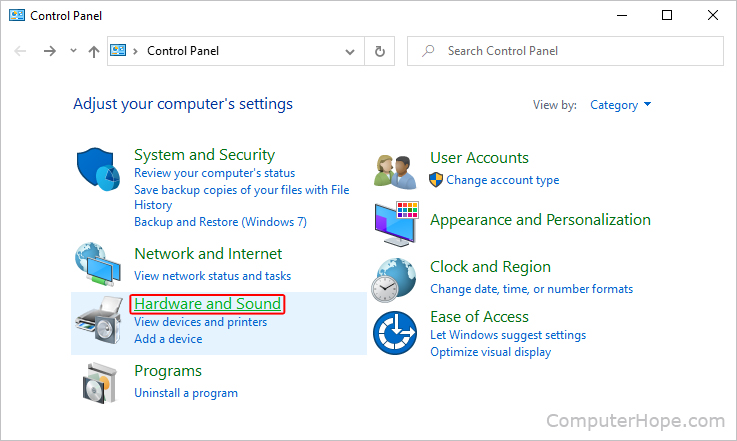
- On the Hardware and Sound screen, under Sound, click Manage audio devices.
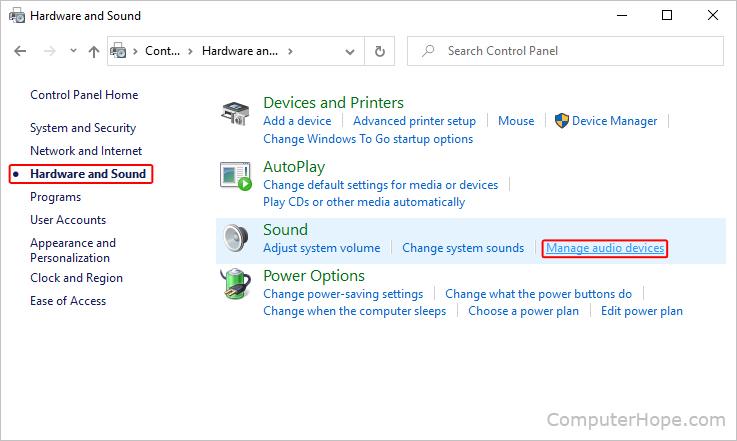
- In the Sound window, on the Playback tab, find the entry for the speakers connected to your computer.
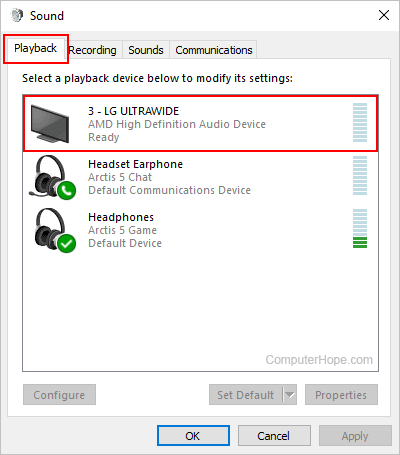
- Right-click the output device entry and select Set as Default Device.
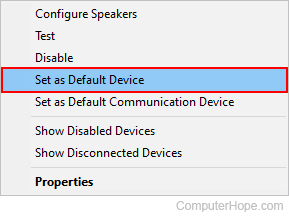
- Click the
 button at the bottom of the Sound window to save your changes.
button at the bottom of the Sound window to save your changes.
Windows speaker setup
If you are running Microsoft Windows, make sure the speaker setup is correct by following the steps below.
- Press the Windows key, type Control Panel, and press Enter.
- In the Control Panel window, click Hardware and Sound.

- On the Hardware and Sound screen, under Sound, click Manage audio devices.

- On the Playback tab, select your output device and click the Configure button.
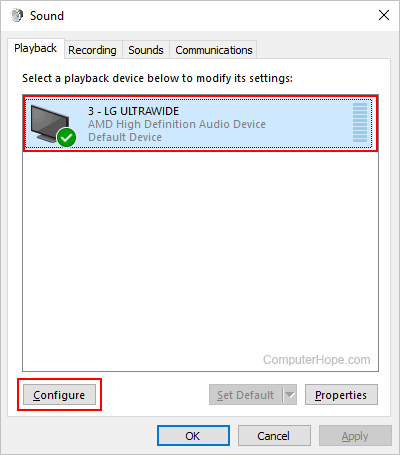
- Click the Test button to check if the speakers are working. If you don't hear any sound from the speakers, click the Next button.
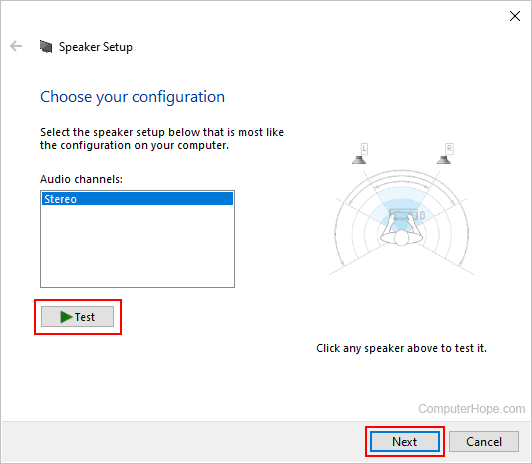
- Check a box under Full-range speakers and click the Next button.
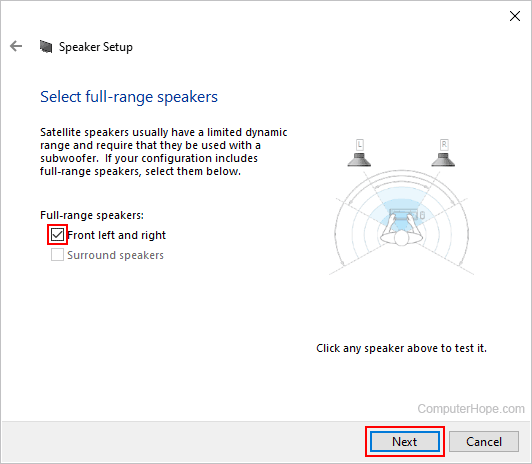
- On the next screen, click the
 button.
button. - If the speakers aren't working, select the speakers again on the Playback tab and click the Properties button.
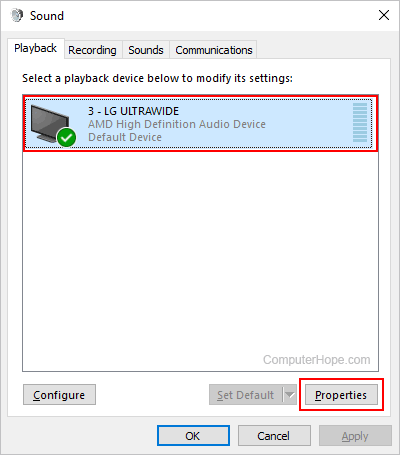
- In the Properties window, click the Advanced tab (A). In the bottom-left corner, click the Restore Defaults button (B). Click the Test button (C).
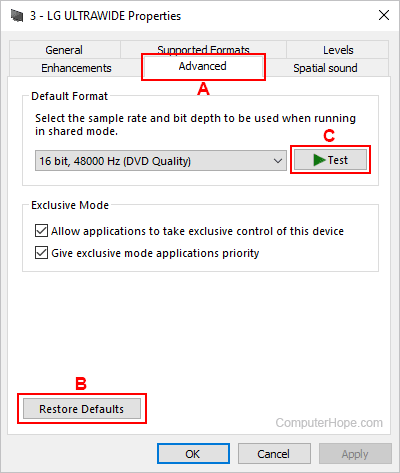
- Ideally, your sound settings are restored and you hear sound again. If not, try adjusting the Default Format by using the down arrow in that section. After completing your changes, click the
 button and the
button and the  button.
button.
Corrupt Windows system files
It is possible for Windows system files to get corrupted for multiple reasons. If system files responsible for sound output are corrupted, the computer can stop producing sound of any kind.
If the computer's sound was working recently but isn't now, try rolling Windows back to a previous restore point when the sound was working. If corrupt Windows system files are causing the sound problem, restoring Windows should resolve the issue. For more information, see: How to restore Windows to an earlier copy.
Make sure to back up your important documents before activating a Windows restore point, as any information saved after that date is lost during the restore process.
Integrated or onboard audio disabled
If your computer has integrated or onboard audio, it's possible it is disabled in the BIOS (basic input/output system).
Access the BIOS and find the entry for integrated audio. It may be located in a menu named something similar to Integrated Peripherals or Onboard Devices, or it may be under the Advanced menu.
After locating the integrated audio entry, check if it's set to Enabled or Disabled. If set to Disabled, change the setting to Enabled. Restart the computer and test the sound.
Bad sound card
If the issue is not software related, it is likely a hardware failure. Make sure the computer sound card works properly by connecting another pair of speakers or headphones to it.
Do not test the sound through a game or another program. Instead, see if a CD (compact disc) or a sound file works. A program or game may have sound-related problems that don't have anything to do with hardware.
If another pair of speakers or headphones also don't work, your sound card is likely defective. See the page linked below for troubleshooting help.
Bad speakers
If none of the recommendations above fix the problem, but connecting a different pair of speakers or headphones did work, the speakers are faulty. We recommend you contact the manufacturer of the speakers or computer for replacement speakers if they are still under warranty. Otherwise, you must buy a new pair of speakers.
